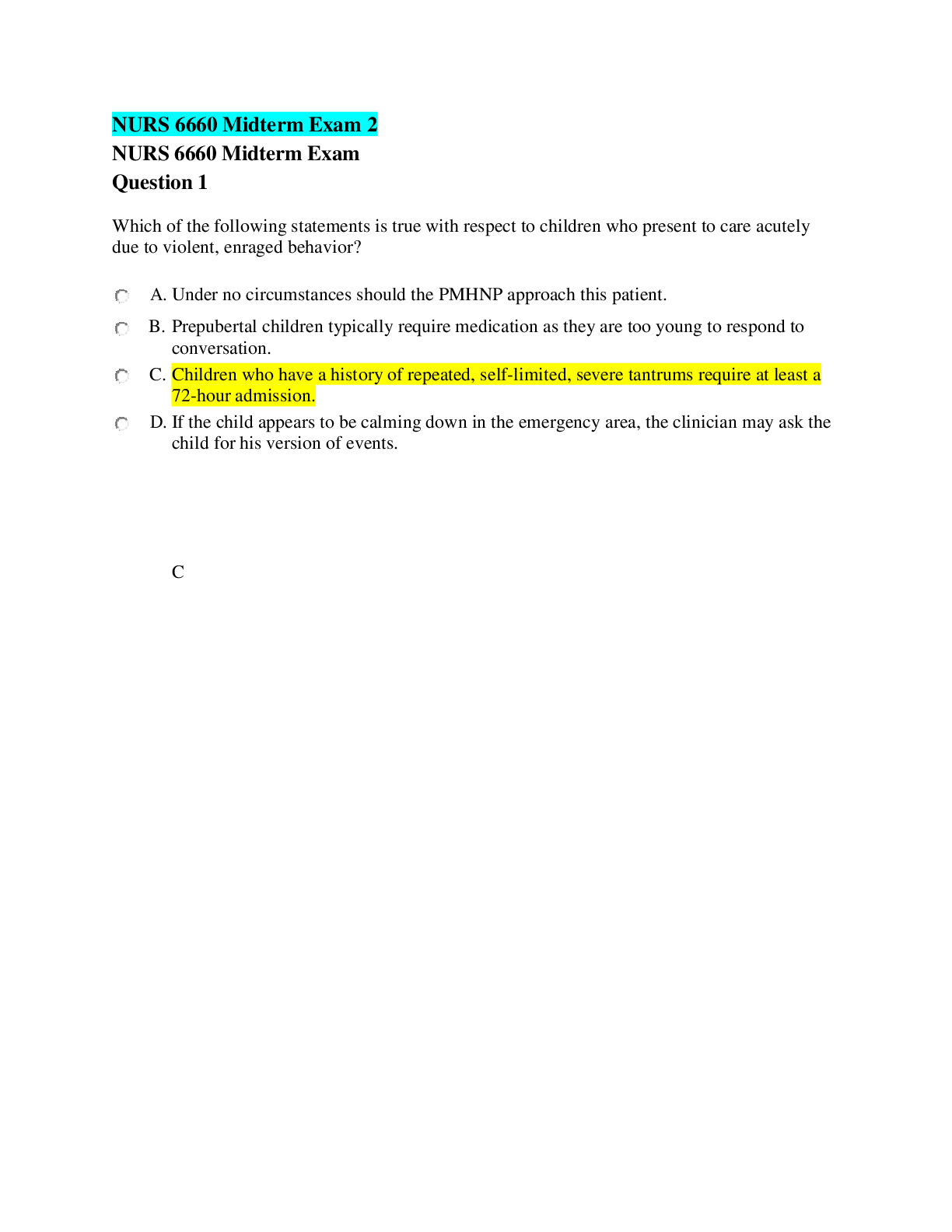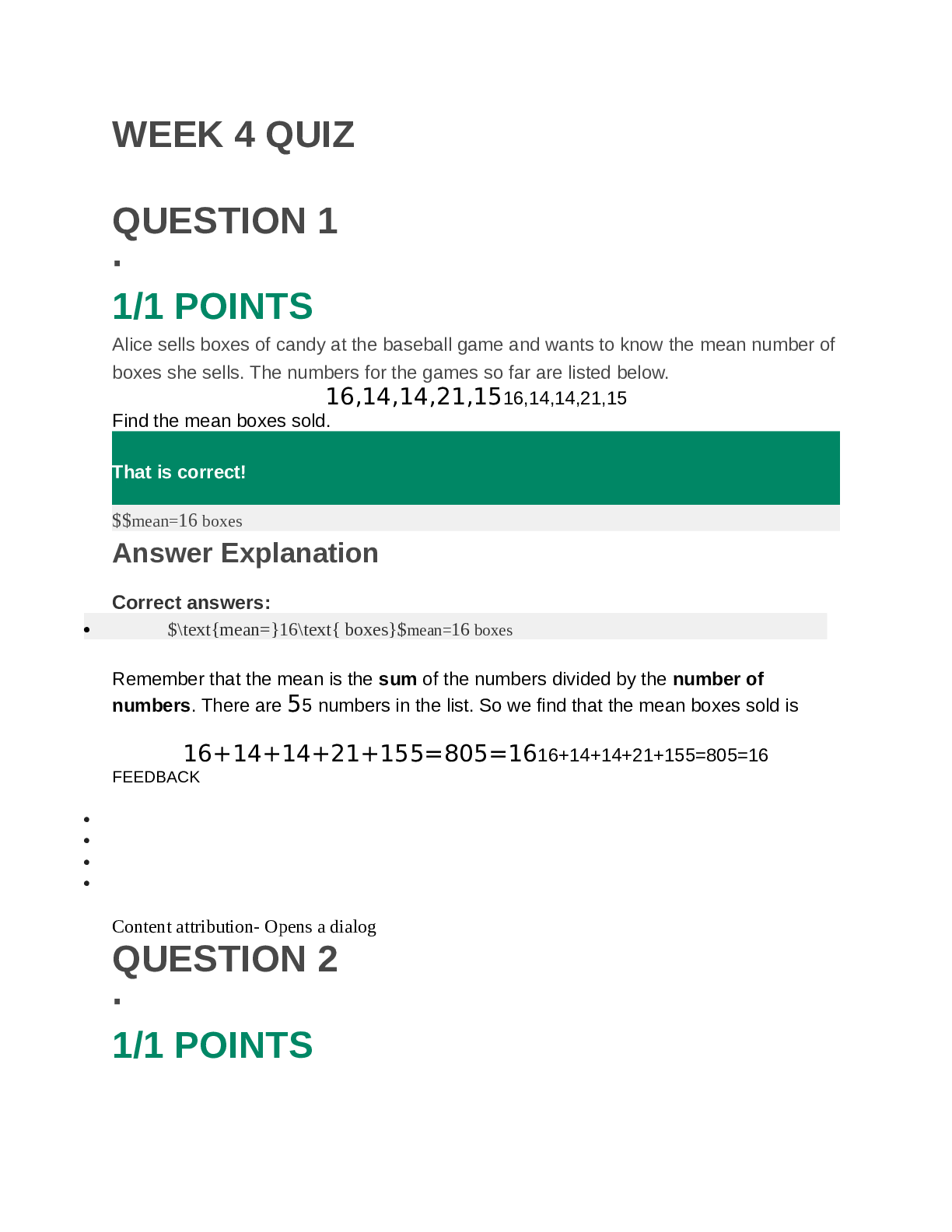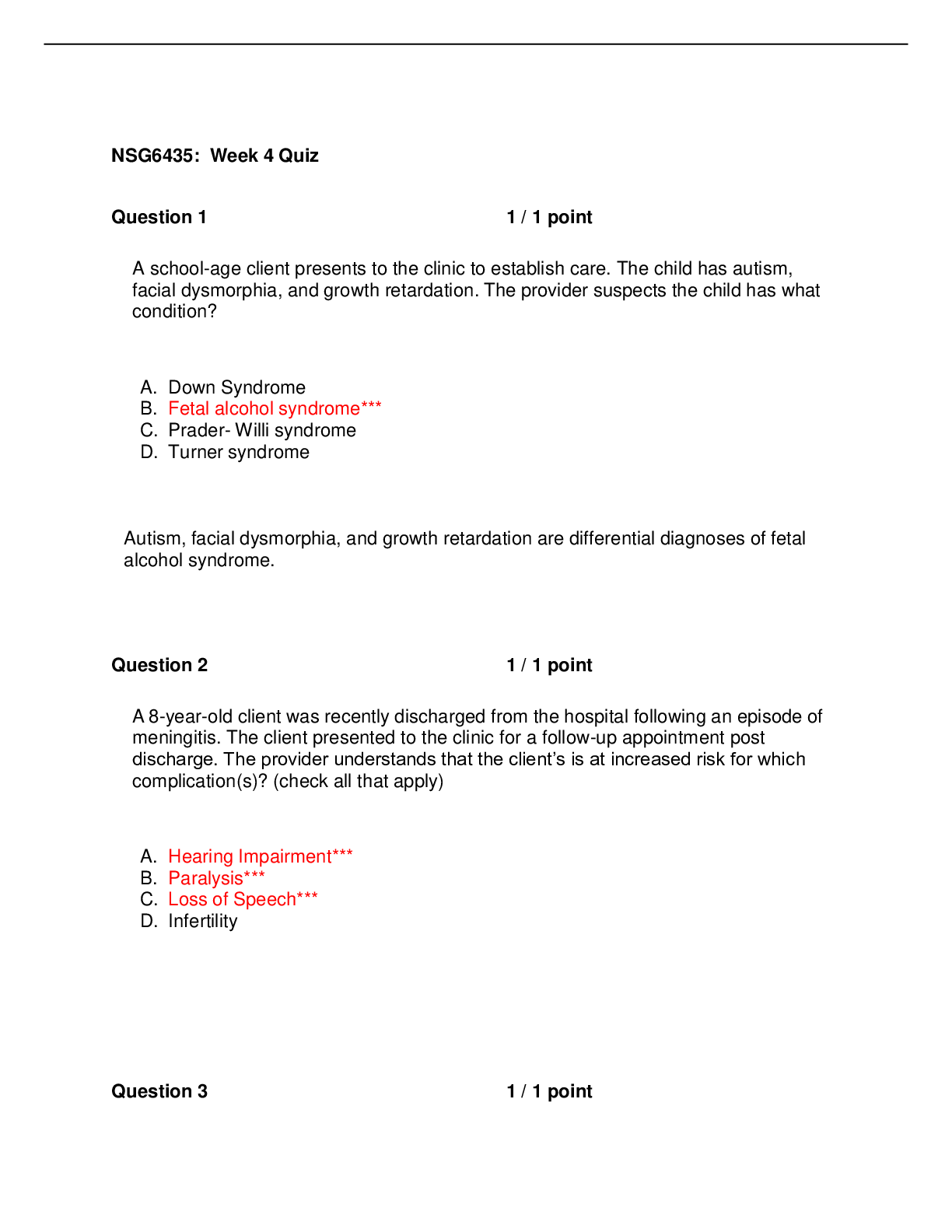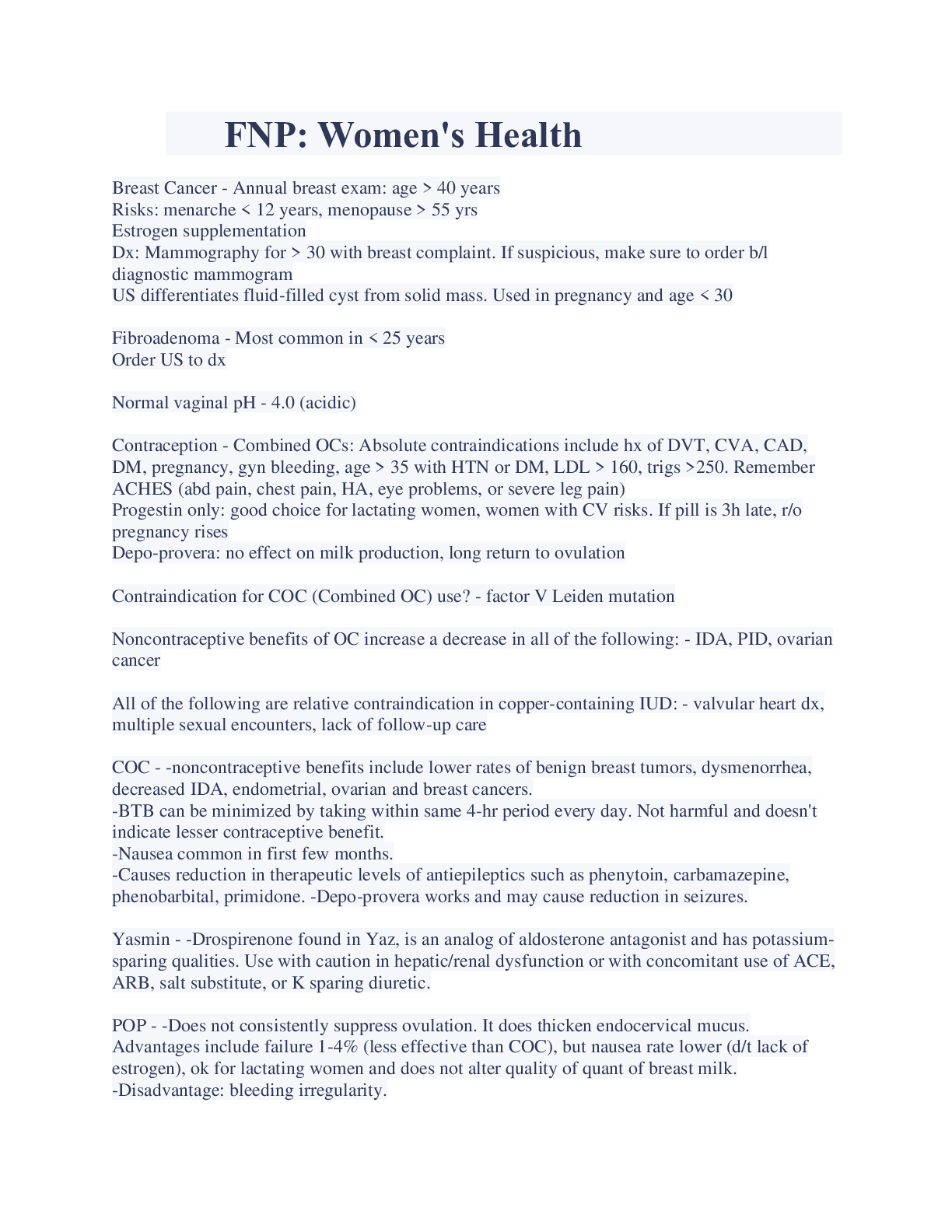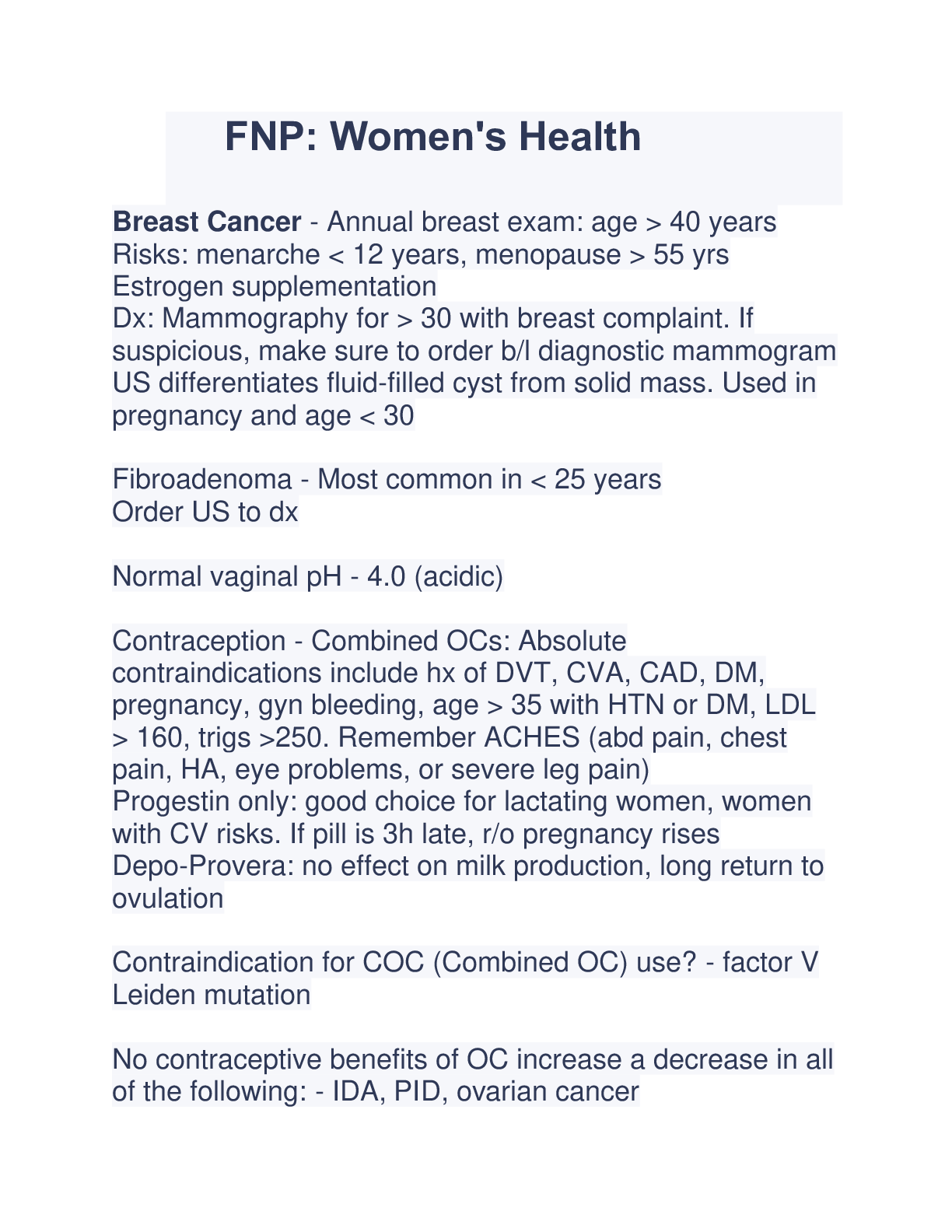NURSING. > EXAM > NSG 6430 : Women's health week 4 quiz, knowledge checks and Midterm | Answered Correctly. (All)
NSG 6430 : Women's health week 4 quiz, knowledge checks and Midterm | Answered Correctly.
Document Content and Description Below
WEEK 4 QUIZ Question 1 The nurse practitioner is prescribing a depot medroxyprogesterone acetate (DMPA) injection for a patient. This medication is given at _______ week intervals. 369 12 Questi... on 2 Although barrier contraception methods are less effective in preventing pregnancy than more modern methods, the nurse practitioner understands that interest in barrier methods is on the rise because they: can help protect against STIs, including HIV are coitus dependent and require planning are nonallergenic and male controlled involve the use of hormones Question 3 A woman is interested in starting Depo-Provera injections for contraception. What would be the most likely side effect that she should be educated about? Irregular bleeding Dysmenorrhea Breast tenderness Headache Question 4 Lenore, fifty-five years old, comes in for evaluation of a breast mass. Which of the following assessment findings is/are associated with carcinoma of the breast? Select all that apply. Scaly lesions similar to eczema on one areola and nipple Peau d’orange dimpling of skin over one breast Unilateral retraction and deviation of nippleDiscrete, smooth, and mobile lesion Question 5 There are several phases to the menstrual cycle. What phase begins with ovulation and ends with menstruation? Ovulatory phase Follicular phase Proliferative phase Luteal phase Question 6 Tanisha is a twenty-two-year-old woman who presents with extreme irritability and mood swings, bloating, constipation, fluid retention, and headache. She tearfully tells you, “This happens every month in my cycle. I get like a crazy woman, lashing out at everyone. I’m afraid I’ll lose my job if I can’t stop this. Sometimes, it’s so bad. I just want to quit living. I need help!” Tanisha’s symptoms are typical of what disorder? Depression Premenstrual syndrome (PMS) Bipolar disorder Premenstrual dysphoric disorder (PMDD) Question 7 Sylvia is a forty-four-year-old woman with abnormal uterine bleeding (AUB) and is unable to use combined hormonal oral contraceptives. Which of the following medications can be used for management of AUB? Ethinyl estradiol Medroxyprogesterone Musculoskeletal relaxants Conjugated estrogen Question 8Your fifteen-year-old patient has been diagnosed with secondary amenorrhea. The urine human chorionic gonadotropin (HCG) is negative and Prolactin levels are within normal limits. The physical examination reveals growth of breast tissue and Tanner stage III. Which of the following medication regimes would be most appropriate? Oral estrogen 1.25 mg daily for three weeks Oral progestin 5 mg every other day for three cycles Medrol 16 mg dose pack Medroxyprogesterone acetate 5 to 10 mg daily for first 12 to 14 days of each cycle Question 9 A female patient has been diagnosed with polycystic ovary syndrome (PCOS) and weighs 250 pounds. In addition to obesity, PCOS is associated with which of the following clinical manifestations? Select all that apply. Unexplained weight loss Dry, flaking skin Menstrual irregularity Hirsutism Question 10 The nurse practitioner is counseling an eleven-year-old girl, Kayleigh, and her mother about the human papillomavirus vaccine (HPV), Gardasil. Kayleigh is Tanner stage IV at this visit. In counseling this family, the nurse practitioner tells them that the HPV vaccine ______. is a series of three doses over a six month period will protect Kayleigh from all strains of HPV can cause seizures in some children is not indicated in her age group as she is not yet sexually active Question 11The nurse practitioner understands that women with polycystic ovarian syndrome have an increased risk for: is a series of three doses over a six month period Adrenal tumors Endometrial cancer Endometriosis Question 12 The nurse practitioner is instructing a patient on the proper use of the diaphragm, a barrier contraceptive method. Which of the following would the nurse practitioner include in the instructions? The diaphragm should be removed within one hour after intercourse. The diaphragm may be inserted up to twenty-four hours prior to intercourse The diaphragm is more effective when used with spermicidal jelly. Douching is safe immediately upon removal of the diaphragm. Question 13 Abnormal uterine bleeding (AUB) has multiple causes. When a woman presents and reports menstrual irregularity with amenorrhea, which is the most common cause of amenorrhea? Ectopic pregnancy Adenomyosis Coagulopathy Anovulation Question 14 Polycystic ovaries predispose women to a higher incidence of: Adrenal tumors Ovarian cancerEndometrial cancer Endometriosis Question 15 A well-woman visit for an adolescent should include which of the following? Select all that apply. A general health history and physical examination, including a breast examination, pelvic with Pap smear, counseling, and assessment of risk factors A general health history focusing on reproductive and sexual health concerns (menses, gynecologic, and pregnancy related) and psychosocial (family related, peer related, emotional, and physical as well as related to abuse, drug use, and alcohol use) concerns Screening tests and immunizations as indicated by the health history External-only inspection of the genitalia Question 16 A 42-year-old female presents to your office with complaint of a palpable breast mass that she noticed while performing her breast self-examination. After taking her history, you perform a clinical breast examination which reveals a solitary, 3 cm, mobile, non-painful, rubbery mass. On the basis of her clinical breast examination, what is most likely her diagnosis? Fibrocystic breast changes Fibroadenoma Intraductal papilloma Invasive breast cancer Question 17 Which of the following contraceptives would not be a reasonable method for a 40-year-old patient that smokes 1 pack of cigarettes per day and has a history of hypertension? Contraceptive patch Depo-Provera Mirena IUDNexplanon Question 18 The nurse practitioner is counseling a patient on the proper use of the vaginal contraceptive ring. Which of the following statements is true? The ring should be replaced weekly throughout the month. The ring can be removed during intercourse for up to 6 hours. The ring should be cleaned daily with soap and water. The ring should be left in place for three weeks then removed during the fourth week for menses. WEEK 5 KNOWLEDGE CHECK Question 1 (1 point) The nurse practitioner is assessing a patient in her last month of pregnancy. Lightening typically occurs during this time, in which the height of the __________ drops slightly. alveoli cervix umbilicus fundus Question 2 (1 point) The nurse practitioner is performing a pelvic exam on a new OB patient. The cervix shows Goodell’s sign when __________; and it shows Chadwick’s sign when __________. it thickens; the mucus plug forms it turns bluish in color; the mucus plug forms it softens; it turns bluish in color hyperplasia occurs; it becomes firm to palpationQuestion 3 (1 point) The nurse practitioner is providing prenatal education regarding pregnancy signs and symptoms. Which of the following is not a sign or symptom associated with pregnancy in the first 6 to 8 weeks? Breast tenderness Urinary frequency Migraine headaches Nausea and vomiting Question 4 (1 point) The nurse practitioner understands that Group B Streptococcus and Escherichia coli are the primary causes of ____________ during pregnancy. urinary tract infections miscarriage toxoplasmosis vaginal bleeding Question 5 (1 point) After delivery, the nurse practitioner understands the process by which the uterus returns to a pre-pregnant state is called: involution deciduation dilation adaptation MIDTERM The nurse practitioner notes a bluish pigmentation of the cervix when doing a pelvic exam on a patient. This pregnancy related sign of pregnancy is known as: Question 1 options: Hegar's sign Chadwick's sign Nightingale's sign Goodell's signQuestion 2 (4 points) The nurse practitioner understands that hyperandrogenism in reproductive-age women is most frequently associated with: Question 2 options: hyperthyroidism polycystic ovarian syndrome ovarian cancer diabetes Question 3 (4 points) The nurse practitioner understands that a first-line recommended treatment for women with PCOS includes which of the following: Question 3 options: photoepilation anabolic steroids analgesics combined oral contraceptives Question 4 (4 points) The nurse practitioner understands that in women of reproductive age, the most common cause of a bleeding pattern that is suddenly different from the woman's established menstrual pattern is: Question 4 options: an increase in estrogen a reaction to a change in eating or exercise habits adrenal hyperplasia a complication of pregnancy Question 5 (4 points)The nurse practitioner is ordering a diagnostic study that involves radiologic imaging of a radiopaque contrast traveling through a woman's uterus and fallopian tubes which is called: Question 5 options: hysteroscopy hysterosalpingogram semen analysis laparoscopy Question 6 (4 points) The nurse practitioner understands that the most common benign breast masses are: Question 6 options: galactoceles hamartomas fibroadenomas and cysts lipomas and phyllodes tumors Question 7 (4 points) Although barrier contraception methods are less effective in preventing pregnancy than more modern methods, the nurse practitioner should educate the patient on which of the following advantages of barrier contraception: Question 7 options: they can help protect against STIs, including HIV they are coitus dependent and require planning they are nonallergenic and male controlled they involve the use of hormones Question 8 (4 points)The nurse practitioner identifies which of the following similarities in colorectal screening recommendations between the U.S Preventative Services Task Force and all other groups: Question 8 options: Screening women age 76 to 85 based on risk factors Screening only for those women at increased risk Screening for all women starting at age 50 Against routine screening in adults age 76 and over Question 9 (4 points) While studying the breast anatomy and physiology, the nurse practitioner student learns that most breast malignancies develop in which area of the breast? Question 9 options: Upper inner quadrant Upper outer quadrant Lower outer quadrant Lower inner quadrant Question 10 (4 points) The nurse practitioner understands that the primary purpose of taking a health history is Question 10 options: To learn about a woman's health concerns To establish a relationship with a woman while learning about her health To identify any unresolved/latent health issues To ensure that a woman's healthcare records are up to date Question 11 (4 points) The nurse practitioner student is studying gynecologic anatomy and physiology for an upcoming exam. The student identifies the function of the Bartholin's gland is Question 11 options:To help prevent infection of the introitus To secrete lubricating mucus into the introitus during sexual excitement To assist in keeping the vaginal introitus closed To secrete estrogen and regulate its levels Question 12 (4 points) The nurse practitioner student is studying the Tanner scale and understands it consists of how many stages of sexual maturity? Question 12 options: 3 stages 5 stages 6 stages 8 stages Question 13 (4 points) Karen is interested in a long-term non-hormonal method of birth control. The nurse practitioner will counsel Karen on which of the following methods? Question 13 options: Progestin-only pill Copper IUD Mirena Ella Question 14 (4 points) Kathy is an 18 year-old patient who chooses to use the vaginal ring for contraception. You ask her what she knows about the vaginal ring and you realize she needs further education when she tells you: Question 14 options: I keep the ring in for 3 weeks then remove it for a week. The vaginal ring delivers both estrogen and progestin hormones.I must change the ring weekly. The ring may offer relief from menorrhagia and dysmenorrhea. Question 15 (4 points) You are seeing Sandy, a 33 year-old female, for her yearly well-woman exam. You are unable to visualize her IUD strings during the pelvic exam. Your response would be to: Question 15 options: re-assure the patient and recheck in 1 year obtain an ultrasound of the pelvis obtain a CT of the pelvis explain to the patient she has expelled the IUD and re-insert a new IUD Question 16 (4 points) The nurse practitioner should counsel the woman on which of the following effects associated with the levonorgestrel intrauterine system known as Mirena: Question 16 options: endometrial hyperplasia hypermenorrhea increase in PID rates reduction in menstrual flow Question 17 (4 points) A 26-year-old mother who breastfeeds her 10-month-old child queries about contraceptives. In counseling her on the use of the progestin-only pill (POP), you mention which of the following: Select all that apply. Question 17 options: the pill must be taken every day POP is a more effective contraceptive than COC POP does not alter the quality or quantity of breast milk POP may be associated with bleeding irregularityQuestion 18 (4 points) When prescribing the contraceptive patch or the vaginal ring to a patient, the nurse practitioner considers that: Question 18 options: both methods are progestin-only products candidates include women who have difficulty remembering to take a daily pill there are significant drug interactions with both products the contraceptive efficacy is less than with oral contraceptives Question 19 (4 points) The nurse practitioner is managing a patient who is experiencing heavy bleeding with Depo Provera. The nurse practitioner understands that management of this problem can be minimized with the use of the following: Question 19 options: supplemental estrogen tylenol calcium and vitamin D increase the Depo Provera dose Question 20 (4 points) A patient and her partner request information on natural family planning. You explain that all of the following may be used to predict occurrence of ovulation except: Question 20 options: monitoring of basal body temperature urine LH test keeping a chart of mood changes monitoring cervical mucous changes Question 21 (4 points)The nurse practitioner is managing a patient currently on Depo-Provera and understands the recommended length of use is: Question 21 options: 1 year no more than 2 years as long as the woman desires this form of contraception as long as the woman desires this form of contraception Question 22 (4 points) A 38-year-old nulliparous woman who smokes two and half packs a day is in an “on-an-off” relationship. The woman presents seeking contraception. Which of the following represents the most appropriate method for this patient? Question 22 options: vaginal ring combined oral contraceptive contraceptive patch Depo-Provera injection Question 23 (4 points) The nurse practitioner is teaching a class on contraception. The class includes a discussion on the noncontraceptive benefits of combined oral contraceptive use which includes a decreased risk for which of the following: Select all that apply. Question 23 options: breast cancer cervicitis endometrial cancer ovarian cancer Question 24 (4 points)The nurse practitioner understands that which of the following patients is the least eligible for combined hormonal contraceptive methods? Question 24 options: patient with hypertension patient with a family history of DVT patient with thyroid disease patient with chronic viral hepatitis Question 25 (4 points) The nurse practitioner is managing an adolescent with primary dysmenorrhea and understands that treatment options include all of the following except: Question 25 options: NSAIDs Prostaglandin inhibitors Melatonin Hormonal contraceptives Question 26 (4 points) The nurse practitioner is treating a patient with Premenstrual Dysphoric Disorder (PMDD). The nurse practitioner's preferred prescriptive therapy for the patient will include which of the following: Question 26 options: Pyridoxine Lithium SSRIs Acupuncture Question 27 (4 points)A 38 year-old presents to the clinic complaining of heavy menstrual bleeding for the past few years. The patient reports the bleeding has become heavier over the past 6 months, reporting bleeding for at least 10 days per month. The patient's hemoglobin is 11 and pelvic ultrasound is normal. The nurse practitioner discusses all of the following treatment options with the patient except: Question 27 options: Progestin-only pills (POP) Mirena Endometrial ablation ParaGard (Copper IUD) Question 28 (4 points) The nurse practitioner student is studying about non-prescriptive methods of treatment for premenstrual syndrome (PMS) which include all of the following except Question 28 options: Evening primrose oil Vitamin E Vitamin A Vitamin B6 Question 29 (4 points) The nurse practitioner understands that a woman's premenstrual syndrome symptoms typically worsen during which phase of the ovarian cycle: Question 29 options: Proliferative Menstrual Follicular Luteal Question 30 (4 points)The nurse practitioner understands that prostaglandins produced in the uterine lining and released into the bloodstream as the lining is shed causes the smooth muscles to contract and is known as: Question 30 options: Pelvic pain Endometriosis Secondary dysmenorrhea Primary dysmenorrhea Question 31 (4 points) Which of the following laboratory tests may be included in the woman who presents with amenorrhea? Select all that apply. Question 31 options: Cervical culture TSH Prolactin Qualitative hCG CBC Question 32 (4 points) The nurse practitioner understands that which of the following factors is associated with secondary amenorrhea: Question 32 options: Congenital absence of uterus and vagina Asherman's syndrome Gonadal failure Constitutional delay Question 33 (4 points) The nurse practitioner understands that performing a guaiac test of the patient's nipple discharge will assess for the presence of:Question 33 options: Precancerous cells Bacteria Hormones Blood Question 34 (4 points) The nurse practitioner is documenting the clinical breast exam findings of a patient with a breast mass. All of the following components should be included in the objective findings of the note except: Question 34 options: Symmetry of the breasts Appearance of the skin Presence of nipple discharge Recent trauma Question 35 (4 points) A 27 year-old presents to her nurse practitioner with a chief complaint of a breast mass for 2 months. The nurse practitioner performs a clinical breast exam and no discrete mass is identified. Which of the following is an appropriate follow-up plan for this patient? Question 35 options: Schedule a diagnostic breast ultrasound Schedule a diagnostic breast mammogram Recheck the patient 1 week after her next menses Refer to breast specialist Question 36 (4 points) The nurse practitioner understands that the American Cancer Society recommends which of the following screening guidelines for mammography in women? Question 36 options:Every other year for women between the ages of 50 and 74 Every three years for women between the ages of 40 and 49 Annual screening beginning at age 40 Every year beginning at age 25 if has first degree relative with breast cancer Question 37 (4 points) Amy is discussing recommended vaccinations during the pregnancy with her nurse practitioner. Which of the following vaccines is recommended with each pregnancy and can be administered at any gestational age? Question 37 options: Measles, mumps, rubella (MMR Varicella Tetanus, diphtheria, pertussis (Tdap) Influenza Question 38 (4 points) The nurse practitioner student is studying postpartum mood and anxiety disorders. The student understands that which of the following statements regarding postpartum blues is correct? Question 38 options: It can occur at any time during the first year postpartum Management includes treatment with antidepressants It is short-lived, lasting less than 14 days Women may have feelings of harming the baby Question 39 (4 points) Janice presents for a routine prenatal check-up at 20 weeks gestation. The nurse practitioner understands that the expected fundal height at this gestation is: Question 39 options: At the level of the symphysis pubis 16 cmSame height as the umbilicus 24 cm Question 40 (4 points) A 21-year old female returns to the clinic for her 28-week prenatal visit. Her labs reveal that her blood type is A negative, antibody screen negative, and hemoglobin 12.1 g/dL. Based on these lab results, the nurse practitioner should: Question 40 options: . Start the patient on Ferrous Sulfate 325 mg TID Repeat the hemoglobin in 2-4 weeks Administer Rhogam to the patient Test the father of the baby's blood type Question 41 (4 points) The nurse practitioner is teaching a patient about the maternal and fetal risks associated with preeclampsia. Which of the following are identified as risks to the fetus? Select all that apply. Question 41 options: Intrauterine growth restriction Oligohydramnios Disseminated intravascular coagulation Renal failure Question 42 (4 points) The nurse practitioner is developing a treatment plan for a postpartum patient with lactation mastitis. Which of the following should be included in the plan of care? Select all that apply. Question 42 options: Increase fluids Application of ice to breasts Continuation of breastfeeding AntibioticsQuestion 43 (4 points) A pregnant patient failed her one-hour GTT and the results to her three-hour GTT are now in. Her fasting was 92, 1-hour was 210, 2-hour was 185, and 3-hour was 135. The nurse practitioner diagnoses the patient with gestational diabetes because: Question 43 options: All four results are abnormal Three out of four results are abnormal Two out of four results are abnormal One out of four results is abnormal Question 44 (4 points) In the first weeks of a viable intrauterine pregnancy, the nurse practitioner understands that the serum quantitative hCG levels should double every _______ hours until it plateaus at approximately 100,000 IU/L. Question 44 options: 24 48 36 72 Question 45 (4 points) Faye presents to the clinic with complaints of amenorrhea, morning sickness, breast tenderness, and frequency with urination. The nurse practitioner evaluates these pregnancy signs as: Question 45 options: Presumptive Probable Objective Positive Question 46 (4 points)You are providing prenatal care to a 22-year-old woman at 18 weeks gestation. She has had a relatively smooth pregnancy without complications thus far. What fetal screening tests should be scheduled for this patient? Question 46 options: 50 gram glucose test Fetal anatomy ultrasound Nuchal translucency ultrasound Varicella antibody screen Question 47 (4 points) A 34-year-old woman presents to the office at 9 weeks' gestation for her first prenatal visit. She reports that she had an episode of spotting 2 weeks earlier with some mild cramping but it has since resolved. Her pelvic examination is unremarkable: cervix is closed with no vaginal bleeding. An office ultrasound is performed and an intrauterine pregnancy is seen with a crownrump length consistent with 7 weeks and 2 days gestation. Unfortunately, no fetal heart-beat is seen. What is your diagnosis? Question 47 options: Complete abortion Threatened abortion Ectopic pregnancy Missed abortion Question 48 (4 points) Louise is currently 29 weeks gestation. Her OB histories include a vaginal delivery to a live male at 40 weeks gestation in 2007; a vaginal delivery to a live female at 36 weeks gestation in 2003; a C/S to a live female at 35 weeks gestation in 2001; and a spontaneous miscarriage at 10 weeks gestation in 1998. Determine Louise's obstetric history using the GTPAL acronym: Question 48 options: G5 T2 P1 A1 L3 G5 T1 P2 A1 L3 G4 T1 P2 A1 L3G6 T2 P1 A1 L3 Question 49 (4 points) Cindy is attending her initial OB exam. Her LMP was October 24th. The nurse practitioner determines Cindy's estimated due date using Nagele's Rule as: Question 49 options: July 31st August 10th July 24th August 4th Question 50 (4 points) The nurse practitioner understands that the pregnancy weight gain goal for an overweight female with a singleton pregnancy should be: Question 50 options: 11-20 pounds 15-25 pounds 25-35 pounds 28-40 pounds KNOWLEDGE CHECKS Lichen sclerosis is a benign, chronic, progressive disease of the skin in which the most common symptom reported by the patient is: Question 1 options: vulvar pruritis vaginal discharge postcoital bleeding dyspareunia Question 2 (1 point)The nurse practitioner educates a patient recently diagnosed with a functional ovarian cyst that it will resolve within: Question 2 options: six months three months six weeks one year Question 3 (1 point) . A patient presents with intense pelvic pain that is less than three months’ duration. The correct term for this type of pain is: Question 3 options: Terminal pelvic pain Cyclic pelvic pain Chronic pelvic pain Acute pelvic pain Question 4 (1 point) The nurse practitioner student was taught to use the mnemonic “OLD CAARTS” when performing a pain history on a patient. What does the “S” stand for? Question 4 options: Severity Scale Somatic Superficial Question 5 (1 point)Janice is being evaluated due to her complaint of chronic pelvic pain. The nurse practitioner informs her that one of the most common gynecological-related causes of chronic pelvic pain is: Question 5 options: Cervical cancer Amenorrhea Dysmenorrhea Endometriosis Kristin presents for an office visit due to an abnormal discharge with a fishy odor. What is the likely diagnosis for Kristin based on her presenting symptoms? Question 1 options: Candidiasis Condyloma Accuminata Bacterial Vaginosis Cervicitis Question 2 (1 point) Which organism causes 90% of vulvovaginal candidiasis episodes in women? Question 2 options: Candida tropicalis Candida albicans Candida glabrata Candida krusei Question 3 (1 point) The nurse practitioner is reviewing reproductive anatomy and understands that the Bartholin’s glands are located within the posteriorlateral vulvar vestibule at ______ and _______. Question 3 options: 11:00 and 1:00 9:00 and 3:00 12:00 and 6:005:00 and 7:00 Question 4 (1 point) Microscopic exam of the vaginal secretions of a patient with chlamydia may reveal the presence of numerous _____________. Question 4 options: pseudohyphae clue cells white blood cells lactobacilli Question 5 (1 point) The nurse practitioner understands that an alternative term sometimes used in place of intimate partner violence is ___________. Question 5 options: domestic violence sexual assault rape neglect Which of the following tests should the nurse practitioner order for HIV confirmation? Question 1 options: EIA ELISA Western blot CD4 count Question 2 (1 point)Which one of the following is the definition of the term gender identity? Question 2 options: People who respond erotically to both sexes A self-label, regardless of biologic or natal sex People who are similar in age, class, and sexual status A label for behavior not usually associated with one’s natal sex Question 3 (1 point) Which one of the following is not among the ways clinicians can provide a welcoming, safe environment for LBQT patients? Question 3 options: Avoid the heterosexual assumption by using gender-neutral language. Explain whether and how information will be documented in the patient’s medical record. Ignore the sexual status or gender identity of all patients. Offer mainstream referrals that are culturally sensitive to this population. Question 4 (1 point) The factors that enable women to enjoy and control their sexual and reproductive lives, including a physical and emotional state of well-being and the quality of sexual and other close relationships, make up a woman’s: Question 4 options: sexual health gender identity gender role behaviors psychosocial orientation Question 5 (1 point)The nurse practitioner may include any of the following methods when managing sexual arousal disorders in women except:. Question 5 options: treatments that decrease blood flow to the genital tissues. the use of vaginal lubricants to increase stimulation. use of the Eros-CTD, a clitoral therapy device. localized estrogen therapy. Question 1 (1 point) The nurse practitioner is counseling a patient about midlife health issues in women and informs the patient that the number one cause of mortality in the United States is Question 1 options: primary osteoporosis. cardiovascular disease. overweight and obesity. cancer (of the lung and bronchus, breast, and colon). Question 2 (1 point) The nurse practitioner understands that an age-related anatomic change that can lead to urinary incontinence is: Question 2 options: The shortening of the urethra The reduction in bladder capacity The increase in habitual preventative emptying of the bladder The decline in number of urethral striated muscle fibers Question 3 (1 point)What is the name for a pelvic muscle contraction that is strategically timed to increase intraurethral pressure just before and after the event that causes urinary incontinence? Question 3 options: Kegel contraction Detrusor maneuver Reverse bladder contraction Knack maneuver Question 4 (1 point) The nurse practitioner is evaluating a patient for pyelonephritis and understands it is distinguished from cystitis in that: Question 4 options: The infection has descended to the bladder. The infection has ascended to the kidneys. The infection is caused by E. coli bacteria. The infection occurs only in pregnant women. Question 5 (1 point) The nurse practitioner is reviewing antibiotic treatment guidelines for uncomplicated lower UTIs and the latest recommendations include which of the following? Question 5 options: Seven-day regimens are now recommended. Three times a day of oral antibiotics are now recommended. Three-day regimens are now recommended. A single dose is now recommended. [Show More]
Last updated: 8 months ago
Preview 4 out of 27 pages

Loading document previews ...
Buy this document to get the full access instantly
Instant Download Access after purchase
Buy NowInstant download
We Accept:

Reviews( 0 )
$12.00
Can't find what you want? Try our AI powered Search
Document information
Connected school, study & course
About the document
Uploaded On
Aug 31, 2019
Number of pages
27
Written in
Additional information
This document has been written for:
Uploaded
Aug 31, 2019
Downloads
0
Views
191




